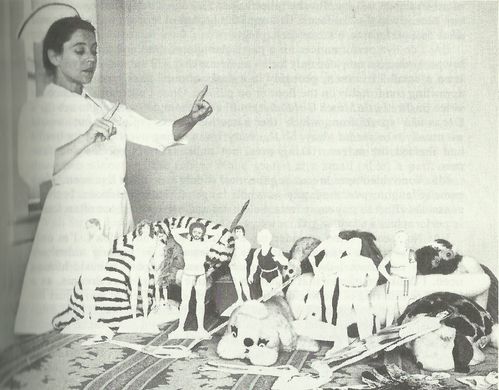Adventures of a Nurse @ Eleanor Antin. 1976

- ANTIN Eleanor, The Adventures of a Nurse (Parts I and II). Adventures as a Nurse, a paper-doll melodrama, 1976, 65 min, color, sound
Nurse Eleanor is the heroine of a paper-doll melodrama, in which she has a succession of romantic encounters with a dying poet, a biker, a doctor, a french ski bum, and an anti-war Senator.
Part I: The artist, in the role of a nurse, fantasizes on romantic themes, using a set of foot-high, hand-painted paper dolls as actors. A fantasy within a fantasy. The « Nurse Eleanor » paper doll performs as a surrogate self for Nurse Eleanor Antin and is the much put-upon but brave heroine of a succession of romances with a dying poet, a biker, and a doctor.
Part II: « Nurse Eleanor’s » romantic odyssey continues with two new lovers — a French ski bum and an anti-war senator.
— Eleanor Antin, « Untitled », Criss Cross Double Cross, v.1, Fall 1976, pp.39-40.
— Sandy Ballatore, « Eleanor Antin: Battle of the Bluffs », Artweek, v.7, February 7, 1976, p.7. Review of Antin’s performance as the exiled King of Solana Beach, at the Los Angeles Institute of Contemporary Art, January 17.
— Jonathan Crary, « Eleanor Antin; Clock Tower Gallery, New York; Exhibit », Arts Magazine, v.50, March 1976, p.8. Review of Antin’s live performance and videotape, The Adventures of a Nurse, presented January 15-31, 1976, at the Clock Tower. Excerpt:
« For the past few years most of Antin’s work has been connected with her creation of four alter egos for herself and the elaboration of the lives of these invented ‘selves’ through a variety of media, particularly live performance. The four roles which she alternatively assumes are a King, a Ballerina, a Black Movie Star, and a Nurse. Each role is an actualization of some fantasy which she amplifies with successive presentations, creating an episodic narrative structure of indeterminate length. One feature of the work is its duration over a period of years and part of its content is how her ongoing articulation of the fictive roles contends with and modifies her identity as Eleanor Antin, California artist. A kind of congruence emerges between this narration of her fantasies, the detailing of these imaginative portraits, and her own autobiography. »
— Mary Stofflet, « Eleanor Antin: An Interview by Mail », La Mamelle Magazine: Art Contemporary, no.3, v.1, Winter 1976, pp.22-23. Excerpts:
MS: Do you do performance specifically for the purpose of making a video piece? For example, The Ballerina and the Bum as a videotape gives no sense of an audience nearby. On the other hand, The King’s Meditation, which I saw at the California Palace of the Legion of Honor, was clearly not done as a performance meant for taping.
EA: I do live performances for a particular space, time and audience. I do my performances on video only for an audience that will subsequently look at it on a small tv screen, probably in the dark, or semi-dark room, hopefully sprawling confortably on the floor or on pillows. Once I used an audience on video (in The Little Match Girl Ballet) but I used them deliberately to set up a Degas-like space from which the narrative I was spieling out would eventually take me far away. So the story I was telling overflowed its banks and flooded the screen, taking over, not unlike Terry’s spoons and faucets…
MS: Your videotapes are among the most widely accessible I’ve seen. They provoke laughter, sadness, pity – a whole range of human reactions. Is this a conscious effort to stay away from the elitism and mysteriousness often found in performance and video art?
EA: No, people often consider me a didactic artist but I don’t. I’m only doing what seems reasonable to me. My interests in making video are primarily narrative. I do think the narrative experience is a basic human need. I think sometimes that it acts on the same principles as dreams, as a kind of re-ordering of the world, putting it together in different ways, just for the hell of it, to try out those ways and paths we discarded in favor of the ones we took. For every step you take in this world you could have taken several others instead. They sit there haunting us, those discarded steps. Narrative is a kind of exorcism, a trying-on of the ‘might-have-beens’, the discards, the losers. You let them in for a while and they stop haunting you. Maybe…
MS: How do you see your involvement with video developing over the next few years, if you plan that far ahead?
EA: Narrative, and more narrative. At this time, I’m making my Nurse Tapes. She, the nurse, plays with paper dolls she’s made herself. They are the actors in these videotapes. They have adventures, fall in love with the Eleanor doll, get discarded by her, kill themselves or whatever. You might say it’s narrative starting on a course of regressions. My invention (the nurse) invents her own inventions (the paper dolls). »
